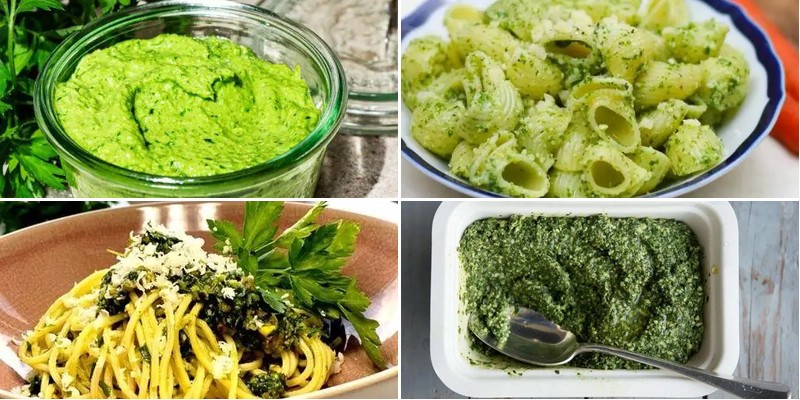Unleash your inner chef with pesto possibilities beyond the traditional! Whether you’re avoiding pine nuts due to allergies, cost, or simply craving variety, these creative twists on classic pesto will transform your weeknight dinners and summer meals. Get ready to discover vibrant flavors that will make your taste buds dance—let’s dive into these delicious alternatives that prove pesto perfection doesn’t need pine nuts!
Arugula Pesto with Walnuts
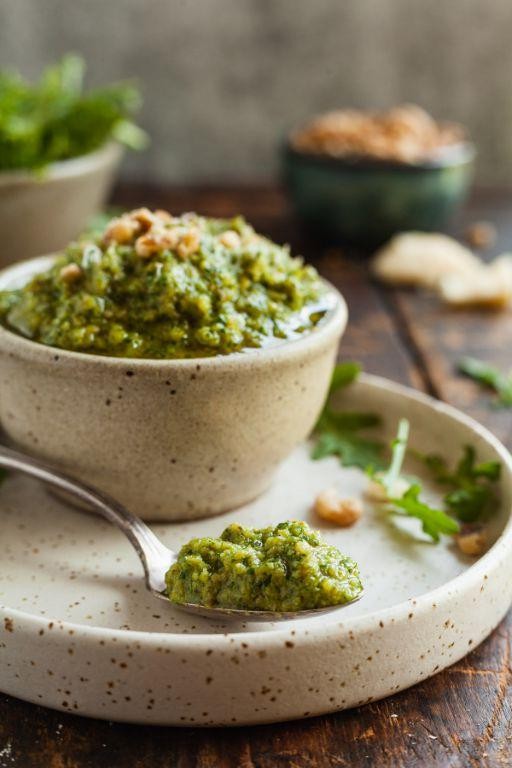
Tackling homemade pesto might seem intimidating, but this arugula-walnut version simplifies the process while delivering sophisticated flavor. The peppery arugula creates a vibrant base that pairs beautifully with toasted walnuts and aged Parmesan. This method ensures perfect emulsion and balanced seasoning every time.
3
servings15
minutes10
minutesIngredients
– 4 cups fresh arugula leaves, tightly packed
– ¾ cup raw walnut halves
– 2 garlic cloves, peeled
– ½ cup extra-virgin olive oil
– ½ cup freshly grated Parmigiano-Reggiano cheese
– 2 tablespoons freshly squeezed lemon juice
– ½ teaspoon fine sea salt
– ¼ teaspoon freshly cracked black pepper
Instructions
1. Preheat your oven to 350°F and spread the walnut halves in a single layer on a baking sheet.
2. Toast the walnuts for 8-10 minutes until fragrant and lightly golden, watching carefully to prevent burning.
3. Transfer the toasted walnuts to a plate and allow them to cool completely to room temperature.
4. Combine the cooled walnuts, garlic cloves, and arugula in the bowl of a food processor fitted with the blade attachment.
5. Pulse the mixture 10-12 times in one-second bursts until coarsely chopped, scraping down the sides with a spatula between pulses.
6. With the food processor running on low speed, slowly drizzle in the olive oil through the feed tube over 30 seconds.
7. Continue processing for another 15 seconds until the mixture forms a coarse paste.
8. Add the grated Parmigiano-Reggiano, lemon juice, sea salt, and black pepper to the food processor bowl.
9. Process the mixture on medium speed for 20-25 seconds until smooth and fully emulsified.
10. Transfer the pesto to an airtight container and press plastic wrap directly against the surface to prevent oxidation.
Arugula’s peppery bite shines through the rich walnut base, creating a pesto with remarkable depth and complexity. The texture remains pleasantly coarse while spreading beautifully over crusty bread or twirling with fresh pasta. For an elegant appetizer, try spreading it over crostini topped with roasted cherry tomatoes and fresh basil leaves.
Basil Spinach Pesto with Cashews
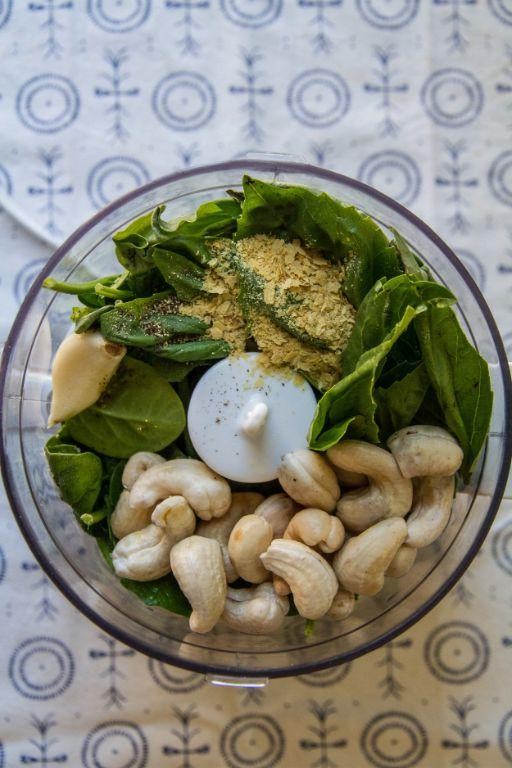
Envision transforming humble greens into a vibrant, aromatic sauce that elevates everyday meals with minimal effort. This basil spinach pesto with cashews balances earthy depth from the spinach with the sweet, herbaceous notes of fresh basil, all while achieving a luxuriously creamy texture from raw cashews instead of traditional pine nuts. You’ll find it remarkably versatile—equally at home tossed with pasta, spread on sandwiches, or dolloped over grilled proteins.
3
servings15
minutes5
minutesIngredients
- 3 cups fresh basil leaves, packed
- 2 cups fresh spinach leaves, packed
- 3/4 cup raw cashews
- 2 large garlic cloves, peeled
- 1/2 cup extra-virgin olive oil
- 1/4 cup freshly grated Parmigiano-Reggiano cheese
- 2 tablespoons freshly squeezed lemon juice
- 1/2 teaspoon fine sea salt
- 1/4 teaspoon freshly cracked black pepper
Instructions
- Place the raw cashews in a small, dry skillet over medium-low heat.
- Toast the cashews for 4-5 minutes, shaking the pan frequently, until they develop light golden spots and release a nutty aroma.
- Transfer the toasted cashews to a plate and allow them to cool completely to room temperature, about 10 minutes.
- Combine the cooled cashews, fresh basil leaves, fresh spinach leaves, and peeled garlic cloves in the bowl of a food processor.
- Pulse the mixture 8-10 times in one-second bursts until the ingredients are roughly chopped.
- Scrape down the sides of the food processor bowl with a rubber spatula to ensure even incorporation.
- With the food processor running on low speed, slowly drizzle in the extra-virgin olive oil through the feed tube over 30 seconds.
- Add the freshly grated Parmigiano-Reggiano cheese, freshly squeezed lemon juice, fine sea salt, and freshly cracked black pepper to the processor bowl.
- Process the mixture on high speed for 45-60 seconds until it forms a smooth, emulsified paste with a consistent pale green color.
- Transfer the finished pesto to an airtight container, pressing plastic wrap directly onto the surface to prevent oxidation.
Notice how the emulsion maintains a velvety texture that clings beautifully to pasta strands without separating. The cashews contribute a buttery richness that complements the peppery basil and slight bitterness from the spinach, while the lemon juice provides just enough acidity to cut through the fat. For a creative twist, thin it with 2 tablespoons of pasta cooking water to create a vibrant salad dressing or use it as a flavorful base for bruschetta topped with heirloom tomatoes and microgreens.
Kale and Almond Pesto
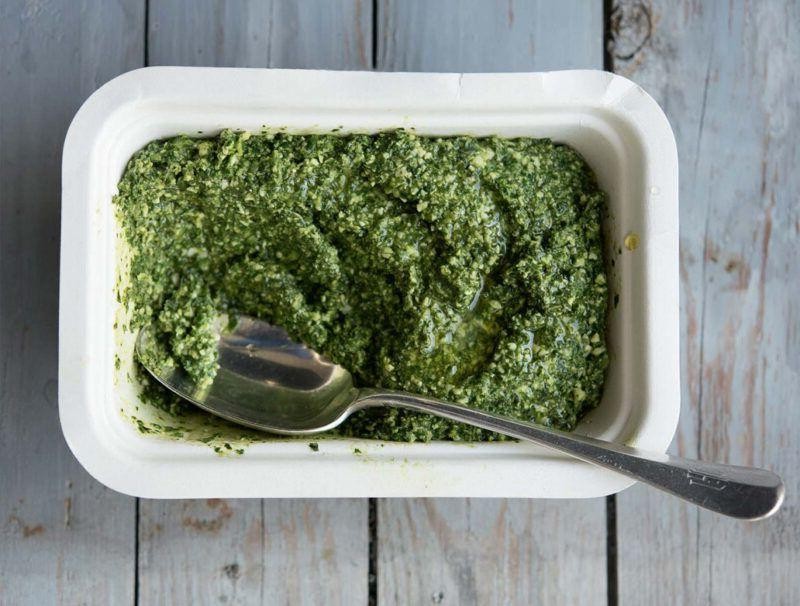
Many home cooks find pesto intimidating, but this kale and almond version simplifies the classic while adding nutritional benefits. Mastering this versatile sauce requires just a few quality ingredients and basic kitchen tools. Follow these precise steps to create a vibrant, restaurant-worthy pesto that will elevate any dish.
2
servings20
minutes10
minutesIngredients
– 3 cups fresh lacinato kale, stems removed and tightly packed
– 1/2 cup raw almonds, lightly toasted
– 2 garlic cloves, peeled and smashed
– 1/2 cup extra virgin olive oil
– 1/4 cup aged Parmesan cheese, finely grated
– 2 tablespoons fresh lemon juice
– 1/2 teaspoon fine sea salt
– 1/4 teaspoon freshly cracked black pepper
Instructions
1. Preheat your oven to 350°F and arrange raw almonds in a single layer on a baking sheet.
2. Toast almonds for 8-10 minutes until fragrant and lightly golden, checking at the 8-minute mark to prevent burning.
3. Remove almonds from oven and let cool completely to room temperature, about 15 minutes.
4. Wash lacinato kale thoroughly and pat completely dry with clean kitchen towels.
5. Remove kale stems by holding the leaf in one hand and stripping the leaf away from the stem with the other.
6. Pack kale leaves tightly into measuring cups until you reach exactly 3 cups.
7. Combine cooled almonds, kale leaves, smashed garlic cloves, and fine sea salt in a food processor bowl.
8. Pulse the mixture 10-12 times in 2-second bursts until ingredients are coarsely chopped.
9. Scrape down the sides of the food processor bowl with a rubber spatula to ensure even mixing.
10. With the food processor running on low speed, slowly drizzle in extra virgin olive oil through the feed tube over 30 seconds.
11. Stop the processor and add finely grated Parmesan cheese and fresh lemon juice.
12. Process the mixture for 15 seconds until smooth but still slightly textured.
13. Transfer the pesto to a glass container and stir in freshly cracked black pepper with a spoon.
14. Taste the pesto and adjust seasoning if necessary, though avoid adding more salt initially.
Fresh pesto should have a vibrant green color and coarse, spreadable texture that clings to pasta. The kale provides earthy undertones while the toasted almonds add nutty complexity that balances the sharp Parmesan. For an elegant presentation, swirl it through warm linguine or use as a flavorful spread for crostini topped with roasted cherry tomatoes.
Parsley Pesto with Sunflower Seeds
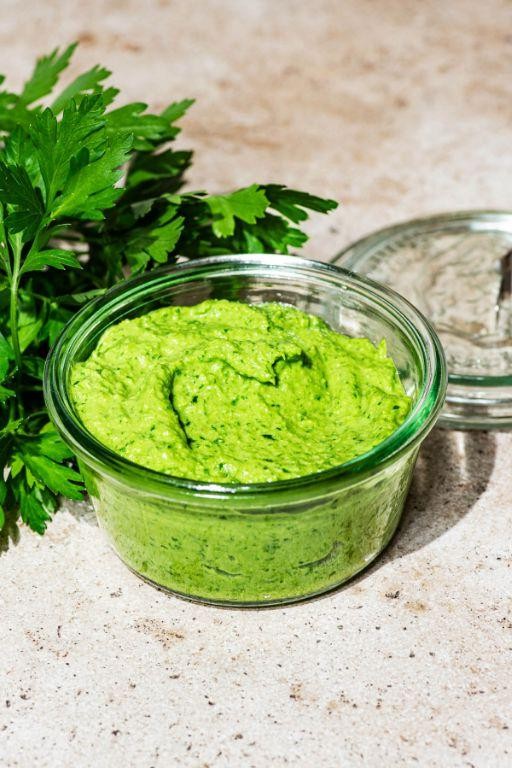
Many home cooks overlook the versatility of parsley, but this vibrant pesto transforms the humble herb into a sophisticated condiment that elevates everything from pasta to proteins. Making pesto from scratch might seem daunting, but following these precise steps ensures a perfectly emulsified, restaurant-quality result every single time.
2
servings15
minutes10
minutesIngredients
– 2 cups fresh flat-leaf parsley leaves, tightly packed
– 1/2 cup raw sunflower seeds
– 2 garlic cloves, peeled
– 1/2 cup extra-virgin olive oil
– 1/4 cup freshly grated Parmigiano-Reggiano
– 2 tablespoons freshly squeezed lemon juice
– 1/2 teaspoon fine sea salt
Instructions
1. Preheat your oven to 350°F.
2. Spread the raw sunflower seeds in a single layer on a baking sheet.
3. Toast the sunflower seeds in the preheated oven for 8-10 minutes until fragrant and lightly golden, stirring once halfway through.
4. Remove the toasted sunflower seeds from the oven and let them cool completely to room temperature, about 15 minutes.
5. Combine the cooled sunflower seeds, fresh flat-leaf parsley leaves, peeled garlic cloves, and fine sea salt in the bowl of a food processor.
6. Pulse the mixture 10-12 times in one-second bursts until coarsely chopped, scraping down the sides with a spatula between pulses.
7. With the food processor running on low speed, slowly drizzle in the extra-virgin olive oil through the feed tube over 30 seconds until the mixture forms a coarse paste.
8. Add the freshly grated Parmigiano-Reggiano and freshly squeezed lemon juice to the food processor bowl.
9. Process the mixture on high speed for 15-20 seconds until the pesto reaches a smooth, emulsified consistency, scraping down the sides once during processing.
10. Transfer the finished pesto to an airtight container, pressing plastic wrap directly against the surface to prevent oxidation.
Refrigerate the pesto for at least 30 minutes before serving to allow the flavors to meld. Remember that proper toasting of the sunflower seeds deepens their nutty flavor, while cooling them completely prevents the pesto from becoming greasy. The technique of slowly drizzling in the oil ensures perfect emulsion, and pressing plastic wrap directly against the surface preserves the vibrant green color. Resulting in a beautifully textured condiment with bright herbaceous notes from the parsley, the pesto offers a delightful crunch from the sunflower seeds balanced by the sharpness of aged cheese. Try tossing it with roasted root vegetables or spreading it beneath the skin of chicken before roasting for an aromatic, flavor-packed dish that will become a staple in your culinary repertoire.
Cilantro and Pumpkin Seed Pesto
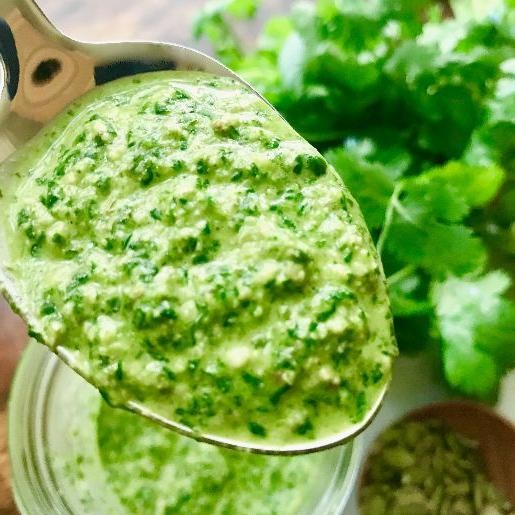
Venturing beyond traditional basil pesto reveals a vibrant, nutty alternative that’s equally versatile in the kitchen. This cilantro and pumpkin seed version offers a fresh, herbaceous flavor profile with a delightful earthy crunch, perfect for elevating simple weeknight meals. Let’s walk through creating this vibrant condiment step by step, ensuring perfect results every time.
5
servings10
minutes6
minutesIngredients
– 2 cups fresh cilantro leaves and tender stems, packed
– 1/2 cup raw pumpkin seeds
– 2 garlic cloves, peeled
– 1/4 cup extra virgin olive oil
– 2 tablespoons freshly squeezed lime juice
– 1/4 teaspoon fine sea salt
Instructions
1. Preheat a dry skillet over medium heat for 2 minutes until hot to the touch when holding your hand 3 inches above the surface.
2. Toast the raw pumpkin seeds in the dry skillet for 3-4 minutes, shaking the pan frequently, until they become fragrant and begin to make popping sounds.
3. Transfer the toasted pumpkin seeds to a plate immediately to prevent residual heat from burning them.
4. Combine the toasted pumpkin seeds, fresh cilantro leaves and tender stems, peeled garlic cloves, and fine sea salt in a food processor bowl.
5. Pulse the mixture 8-10 times in 1-second bursts until the ingredients are coarsely chopped.
6. With the food processor running on low speed, slowly drizzle in the extra virgin olive oil through the feed tube over 30 seconds.
7. Add the freshly squeezed lime juice and continue processing for 15 seconds until the pesto reaches a coarse, spreadable consistency.
8. Scrape down the sides of the food processor bowl with a rubber spatula to incorporate any unblended ingredients.
9. Process for an additional 10 seconds until the pesto is uniformly mixed but still maintains some texture from the pumpkin seeds.
10. Transfer the finished pesto to an airtight container, pressing plastic wrap directly onto the surface to prevent oxidation.
A beautifully textured pesto emerges with the bright, citrusy notes of cilantro balanced by the toasty warmth of pumpkin seeds. The coarse grind provides satisfying crunch while the emulsion creates a luxurious mouthfeel that clings perfectly to pasta or acts as a vibrant sandwich spread. Consider swirling it into roasted vegetable soups or using it as a marinade for grilled chicken to explore its full culinary potential.
Mint and Walnut Pesto
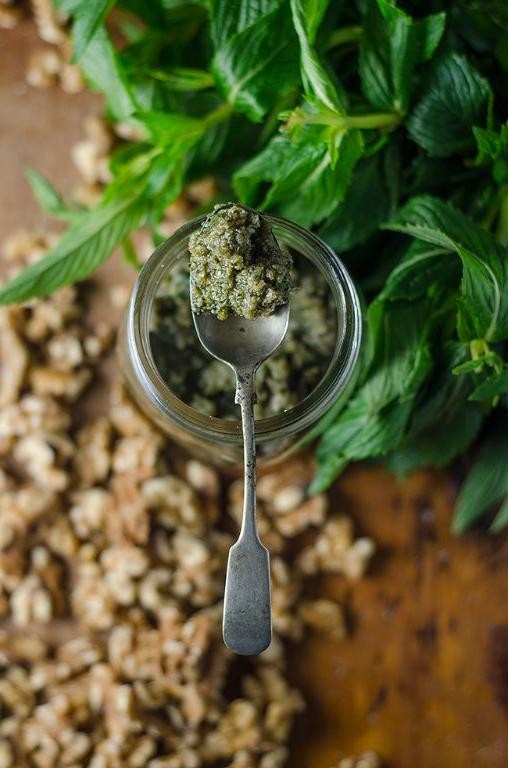
During those moments when you crave something simultaneously fresh and rich, this mint and walnut pesto delivers vibrant flavor with minimal effort. Developing this recipe required balancing the bright, cooling notes of mint against the earthy depth of walnuts, creating a versatile sauce that elevates everything from pasta to proteins.
4
servings15
minutes10
minutesIngredients
– 2 cups fresh mint leaves, packed
– 3/4 cup raw walnut halves
– 1/2 cup extra-virgin olive oil
– 1/3 cup Parmigiano-Reggiano, finely grated
– 2 garlic cloves, peeled
– 1 tablespoon freshly squeezed lemon juice
– 1/2 teaspoon fine sea salt
– 1/4 teaspoon freshly cracked black pepper
Instructions
1. Preheat your oven to 350°F and arrange the walnut halves in a single layer on a baking sheet.
2. Toast the walnuts for 8-10 minutes until fragrant and lightly golden, watching carefully to prevent burning.
3. Transfer the toasted walnuts to a plate and allow them to cool completely to room temperature, about 15 minutes.
4. Combine the cooled walnuts, fresh mint leaves, garlic cloves, grated Parmigiano-Reggiano, fine sea salt, and black pepper in a food processor bowl.
5. Pulse the mixture 8-10 times in one-second bursts until coarsely chopped, scraping down the sides with a spatula as needed.
6. With the food processor running on low speed, slowly drizzle in the extra-virgin olive oil through the feed tube over 30 seconds.
7. Add the freshly squeezed lemon juice and continue processing for another 15 seconds until the pesto reaches a slightly coarse, spreadable consistency.
8. Transfer the finished pesto to an airtight container, pressing plastic wrap directly against the surface to prevent oxidation.
9. Refrigerate the pesto for at least 30 minutes to allow the flavors to meld before serving. Notably, this pesto maintains a delightful textural contrast between the creamy oil base and the subtle crunch of walnuts. The bright mint forwardness gives way to the cheese’s umami depth, making it exceptional tossed with hot linguine or spread over grilled lamb chops for an elegant dinner.
Roasted Red Pepper Avocado Pesto
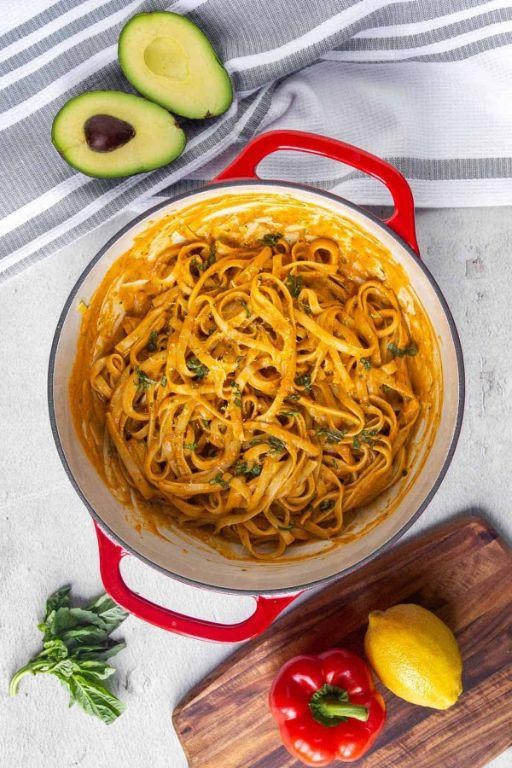
Ready to elevate your pasta game with minimal effort? Roasted red pepper avocado pesto combines vibrant, sweet peppers with creamy avocado for a luxuriously smooth sauce that comes together in minutes. This versatile condiment transforms simple ingredients into restaurant-quality dishes with its brilliant color and balanced flavor profile.
2
servings20
minutes30
minutesIngredients
– 2 large red bell peppers, roasted and peeled
– 1 ripe Hass avocado, pitted and scooped
– ¼ cup raw pine nuts, lightly toasted
– 2 cloves fresh garlic, minced
– ½ cup extra virgin olive oil
– ¼ cup freshly grated Parmigiano-Reggiano
– 1 tablespoon freshly squeezed lemon juice
– ½ teaspoon fine sea salt
– ¼ teaspoon freshly cracked black pepper
Instructions
1. Preheat your oven to 425°F and line a baking sheet with parchment paper.
2. Place whole red bell peppers on the prepared baking sheet and roast for 25-30 minutes until the skins are completely blackened and blistered.
3. Transfer the roasted peppers to a heatproof bowl and cover tightly with plastic wrap, allowing them to steam for 15 minutes—this crucial step makes peeling effortless.
4. While peppers steam, toast pine nuts in a dry skillet over medium heat for 3-4 minutes, shaking the pan frequently until golden brown and fragrant.
5. Carefully peel the blackened skins from the peppers, then remove stems and seeds, reserving any accumulated juices.
6. Combine the peeled peppers, toasted pine nuts, minced garlic, and scooped avocado in a food processor bowl.
7. Pulse the mixture 5-6 times until coarsely chopped, then scrape down the sides with a rubber spatula to ensure even processing.
8. With the processor running on low speed, slowly drizzle in the extra virgin olive oil through the feed tube until fully incorporated.
9. Add the grated Parmigiano-Reggiano, lemon juice, sea salt, and black pepper, then process for 30 seconds until perfectly smooth and emulsified.
10. Taste and adjust seasoning if necessary, remembering the cheese contributes saltiness.
This pesto achieves a remarkably velvety texture that clings beautifully to pasta while delivering bright, herbaceous notes with subtle smokiness from the roasted peppers. Try it as a vibrant spread for crusty bread or thinned with pasta water for an elegant sauce that coats each strand perfectly.
Zucchini and Pistachio Pesto
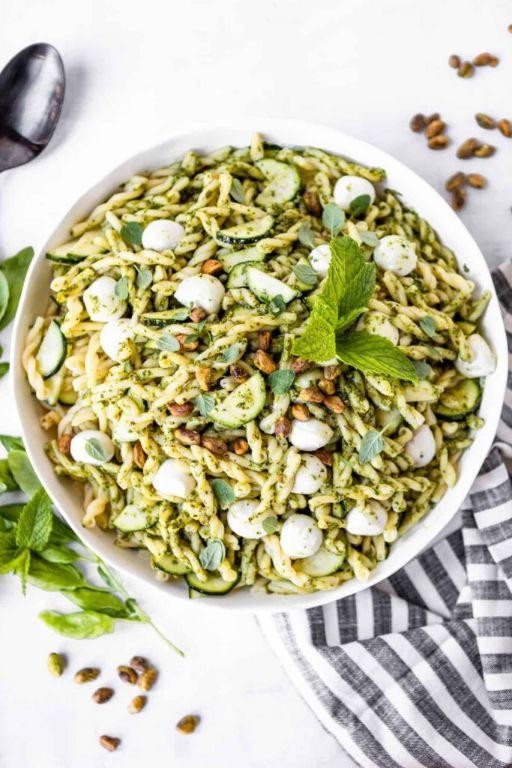
Keeping your summer zucchini harvest exciting can be a challenge, but this vibrant pesto transforms the humble vegetable into something truly special. Knowing how to properly prepare each component ensures a perfectly balanced sauce every time. Let’s walk through creating this fresh, nutty condiment together.
3
servings20
minutes25
minutesIngredients
– 2 medium zucchini, ends trimmed
– 1 cup raw shelled pistachios
– 2 garlic cloves, peeled
– 1/2 cup extra virgin olive oil
– 1/4 cup freshly grated Parmigiano-Reggiano
– 2 tablespoons freshly squeezed lemon juice
– 1 teaspoon fine sea salt
– 1/2 teaspoon freshly cracked black pepper
Instructions
1. Preheat your oven to 400°F and line a baking sheet with parchment paper.
2. Cut the zucchini into 1/2-inch thick rounds and arrange them in a single layer on the prepared baking sheet.
3. Roast the zucchini for 20 minutes until tender and lightly golden around the edges.
4. Transfer the roasted zucchini to a wire rack and cool completely to room temperature, about 15 minutes.
5. While zucchini cools, toast the pistachios in a dry skillet over medium heat for 5 minutes, shaking the pan frequently until fragrant and lightly browned.
6. Combine the cooled zucchini, toasted pistachios, garlic cloves, olive oil, Parmigiano-Reggiano, lemon juice, sea salt, and black pepper in a food processor.
7. Pulse the mixture 10 times in 1-second bursts to break down the ingredients.
8. Process continuously for 45 seconds until the pesto reaches a coarse, spreadable consistency, scraping down the sides halfway through.
9. Taste the pesto and adjust seasoning if necessary before transferring to an airtight container.
Using freshly roasted zucchini creates a deeper, caramelized flavor base that shines through the bright pistachio notes. Ultimately, this pesto offers a creamy texture with satisfying nutty crunch and makes an exceptional spread for grilled bread or stirred into hot pasta for an instant summer meal.
Broccoli and Hemp Seed Pesto
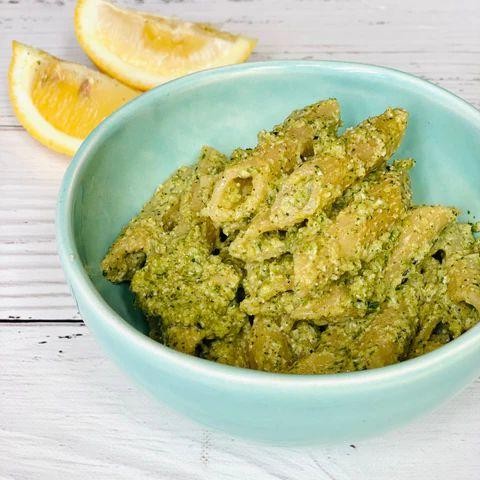
Venturing beyond traditional basil pesto reveals exciting flavor possibilities. This broccoli and hemp seed version offers a nutrient-dense twist that maintains the creamy texture pesto lovers crave while introducing earthy, nutty undertakes. Let’s methodically walk through creating this vibrant green sauce that pairs beautifully with pasta, grains, or as a vegetable dip.
4
servings15
minutes2
minutesIngredients
– 2 cups fresh broccoli florets, blanched and shocked
– 1/2 cup raw hemp seeds
– 1/3 cup extra virgin olive oil, cold-pressed
– 2 garlic cloves, peeled and smashed
– 1/4 cup nutritional yeast
– 2 tablespoons freshly squeezed lemon juice
– 1 teaspoon fine sea salt
– 1/4 teaspoon freshly cracked black pepper
Instructions
1. Bring a medium saucepan of salted water to a rolling boil at 212°F.
2. Submerge broccoli florets completely in boiling water and blanch for exactly 90 seconds.
3. Immediately transfer blanched broccoli to an ice water bath using a slotted spoon to shock and preserve vibrant green color.
4. Drain broccoli thoroughly and pat dry with paper towels to remove excess moisture.
5. Combine blanched broccoli, raw hemp seeds, smashed garlic cloves, nutritional yeast, fine sea salt, and freshly cracked black pepper in a food processor bowl.
6. Pulse the mixture 8-10 times in 2-second bursts until ingredients are coarsely chopped.
7. With the food processor running on low speed, slowly drizzle in cold-pressed extra virgin olive oil through the feed tube over 30 seconds.
8. Add freshly squeezed lemon juice and continue processing for 15 seconds until the pesto reaches a creamy, spreadable consistency.
9. Scrape down the sides of the food processor bowl with a rubber spatula to incorporate any unblended ingredients.
10. Process for an additional 10 seconds to achieve a perfectly emulsified texture.
Ultimately, this pesto delivers a remarkably creamy mouthfeel with subtle earthy notes from the hemp seeds balanced by the bright acidity of lemon. Use it as a sophisticated sandwich spread, toss with roasted root vegetables, or thin with additional olive oil for an elegant salad dressing that showcases its complex flavor profile.
Lemon Herb Pesto with Almonds
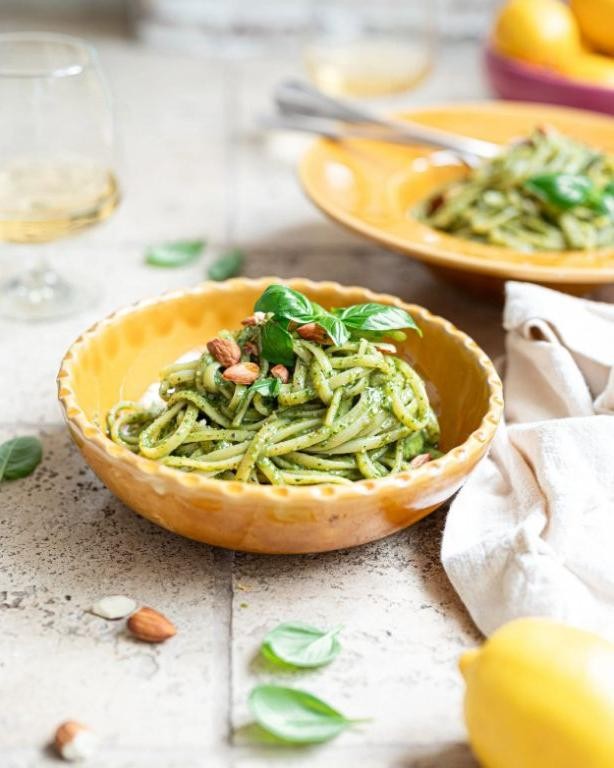
Just imagine transforming simple ingredients into a vibrant, aromatic sauce that elevates any dish. Lemon herb pesto with almonds offers a bright, nutty alternative to traditional basil pesto, perfect for pasta, grilled proteins, or as a dipping sauce. Let’s walk through each step methodically to ensure your pesto turns out perfectly balanced and full of fresh flavor.
5
servings15
minutes10
minutesIngredients
- 2 cups fresh basil leaves, tightly packed
- 1/2 cup raw almonds, toasted
- 2 cloves garlic, minced
- 1/2 cup extra-virgin olive oil
- 1/4 cup freshly grated Parmigiano-Reggiano cheese
- 2 tablespoons freshly squeezed lemon juice
- 1/2 teaspoon fine sea salt
Instructions
- Preheat your oven to 350°F and spread the raw almonds in a single layer on a baking sheet.
- Toast the almonds for 8–10 minutes until fragrant and lightly golden, shaking the pan halfway through to ensure even toasting.
- Allow the toasted almonds to cool completely to room temperature, about 15 minutes, to prevent steaming in the food processor.
- Combine the cooled almonds, fresh basil leaves, minced garlic, and fine sea salt in a food processor fitted with the blade attachment.
- Pulse the mixture 10–12 times in 1-second bursts until coarsely chopped, scraping down the sides with a spatula after every 3–4 pulses.
- With the food processor running on low speed, slowly drizzle in the extra-virgin olive oil over 30 seconds until the mixture forms a coarse paste.
- Add the freshly grated Parmigiano-Reggiano cheese and freshly squeezed lemon juice to the food processor bowl.
- Process the mixture on high speed for 20–25 seconds until smooth and emulsified, stopping once to scrape down the sides.
- Taste the pesto and adjust seasoning if needed, remembering the cheese adds saltiness.
The finished pesto should have a creamy yet textured consistency with visible almond flecks, delivering a bright lemon tang that cuts through the rich garlic and nutty flavors. Try tossing it with hot linguine and grilled shrimp, or spread it on crostini topped with heirloom tomatoes for a fresh appetizer.
Spinach and Brazil Nut Pesto
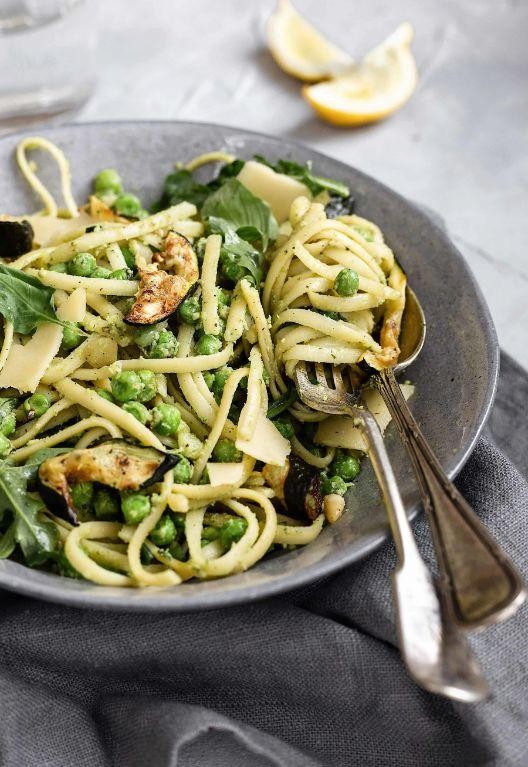
Whether you’re looking to elevate your pasta game or simply want a vibrant, nutrient-dense sauce, this spinach and Brazil nut pesto offers a delightful twist on the classic. With its emerald hue and complex flavor profile, it transforms simple ingredients into something truly special. We’ll walk through each step methodically to ensure perfect results every time.
5
servings15
minutes10
minutesIngredients
- 3 cups fresh baby spinach leaves, tightly packed
- 1/2 cup raw Brazil nuts, toasted
- 1/2 cup extra virgin olive oil
- 1/4 cup freshly grated Parmigiano-Reggiano cheese
- 2 tablespoons freshly squeezed lemon juice
- 2 garlic cloves, peeled and smashed
- 1/2 teaspoon fine sea salt
- 1/4 teaspoon freshly cracked black pepper
Instructions
- Preheat your oven to 350°F and arrange the raw Brazil nuts in a single layer on a baking sheet.
- Toast the Brazil nuts for 8-10 minutes until fragrant and lightly golden, shaking the pan halfway through for even toasting.
- Transfer the toasted Brazil nuts to a cutting board and allow them to cool completely to room temperature, about 15 minutes.
- Roughly chop the cooled Brazil nuts into smaller pieces to help your food processor achieve a more uniform texture.
- Combine the chopped Brazil nuts, fresh baby spinach leaves, smashed garlic cloves, and fine sea salt in the bowl of a food processor fitted with the blade attachment.
- Pulse the mixture 10-12 times in one-second bursts until the ingredients are coarsely chopped but not pureed.
- Scrape down the sides of the food processor bowl with a rubber spatula to ensure all ingredients are incorporated evenly.
- With the food processor running on low speed, slowly drizzle in the extra virgin olive oil through the feed tube over 30 seconds.
- Add the freshly grated Parmigiano-Reggiano cheese and freshly squeezed lemon juice to the mixture in the food processor.
- Process the pesto for 15-20 seconds until smooth but still slightly textured, stopping to scrape down the sides once during processing.
- Season the pesto with freshly cracked black pepper and process for an additional 5 seconds to incorporate.
- Taste the pesto and adjust seasoning if necessary, keeping in mind the saltiness of the Parmigiano-Reggiano.
Smooth yet textured with visible flecks of emerald spinach and golden Brazil nuts, this pesto delivers a rich, buttery flavor with subtle earthy undertones. The bright acidity from fresh lemon juice cuts through the richness beautifully, creating a balanced sauce that clings perfectly to pasta. Try spreading it on crostini with roasted tomatoes or using it as a vibrant base for grilled chicken sandwiches.
Rocket and Pistachio Pesto
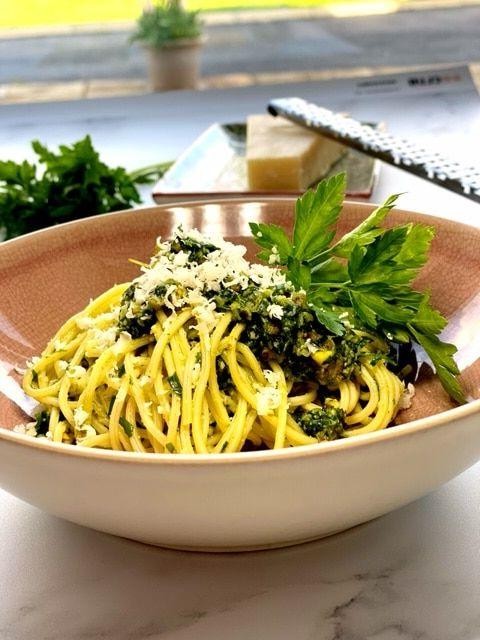
Venturing beyond traditional basil pesto reveals this vibrant rocket and pistachio variation that brings peppery notes and nutty complexity to your table. Let’s methodically walk through creating this sophisticated condiment from start to finish, ensuring perfect texture and balanced flavor at each stage.
Ingredients
– 3 cups fresh wild arugula leaves, thoroughly dried
– ¾ cup raw unsalted pistachios, shelled
– 2 medium garlic cloves, peeled and smashed
– ½ cup extra virgin olive oil, divided
– ¼ cup freshly grated Parmigiano-Reggiano cheese
– 2 tablespoons freshly squeezed lemon juice
– ½ teaspoon fine sea salt
Instructions
1. Preheat your oven to 350°F and arrange pistachios in a single layer on a baking sheet.
2. Toast pistachios for 6-8 minutes until fragrant and lightly golden, shaking the pan halfway through for even toasting.
3. Transfer toasted pistachios to a plate and cool completely to room temperature, about 15 minutes.
4. Combine cooled pistachios, arugula, garlic cloves, and fine sea salt in a food processor bowl.
5. Pulse the mixture 8-10 times in 2-second bursts until coarsely chopped, scraping down the sides with a spatula after every 3 pulses.
6. With the food processor running on low speed, slowly drizzle in ¼ cup of extra virgin olive oil through the feed tube over 30 seconds.
7. Add freshly grated Parmigiano-Reggiano cheese and freshly squeezed lemon juice to the mixture.
8. Process for 15-20 seconds until the pesto reaches a coarse paste consistency, not completely smooth.
9. Transfer the pesto to an airtight container and pour the remaining ¼ cup of extra virgin olive oil over the surface to create a protective layer.
Expect this pesto to deliver a beautifully coarse texture with visible pistachio pieces and vibrant green arugula flecks throughout. The peppery rocket base harmonizes with the rich, buttery pistachios while the lemon juice provides just enough acidity to balance the richness. Consider swirling it into warm pasta, spreading it on crostini with burrata, or using it as a marinade for grilled chicken to showcase its versatility.
Pea and Mint Pesto with Hazelnuts
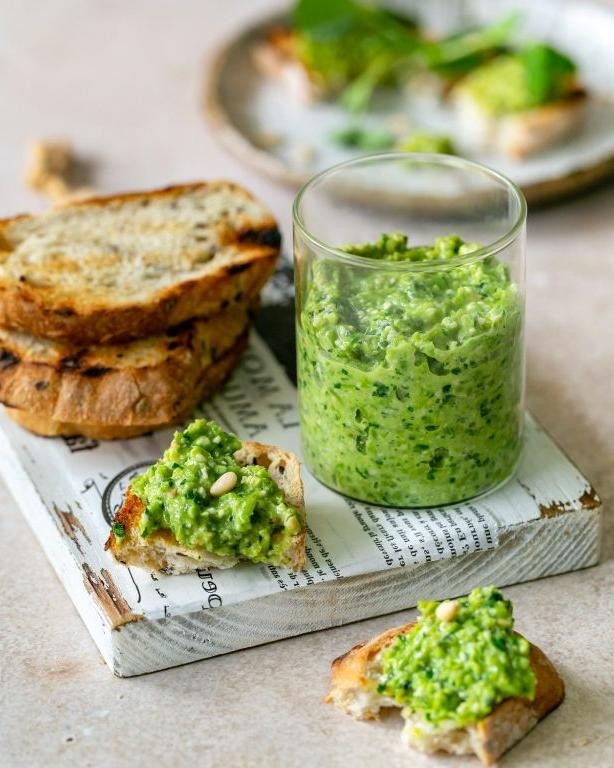
Now, let’s create a vibrant pesto that transforms simple peas into something extraordinary. Nothing beats the fresh combination of sweet peas and aromatic mint, especially when paired with toasted hazelnuts for depth. This methodical approach ensures perfect texture and balanced flavors every time.
Ingredients
- 2 cups fresh English peas, blanched
- 1/2 cup fresh mint leaves, tightly packed
- 1/3 cup toasted hazelnuts, skins removed
- 1/2 cup extra-virgin olive oil
- 1/4 cup Parmigiano-Reggiano, finely grated
- 2 tablespoons freshly squeezed lemon juice
- 1 small garlic clove, microplaned
- 1/2 teaspoon fine sea salt
- 1/4 teaspoon freshly cracked black pepper
Instructions
- Bring a medium saucepan of salted water to a rolling boil at 212°F.
- Blanch the fresh English peas for exactly 90 seconds until bright green and tender-crisp.
- Immediately transfer the blanched peas to an ice water bath using a spider strainer to halt the cooking process.
- Toast the hazelnuts in a dry skillet over medium heat for 5-7 minutes, shaking frequently until golden and fragrant.
- Rub the toasted hazelnuts vigorously in a clean kitchen towel to remove the bitter skins.
- Combine the cooled peas, mint leaves, and skinned hazelnuts in a food processor fitted with the S-blade.
- Pulse the mixture 8-10 times in one-second bursts until coarsely chopped.
- With the processor running on low speed, slowly drizzle in the extra-virgin olive oil through the feed tube over 30 seconds.
- Add the microplaned garlic, fine sea salt, and freshly cracked black pepper to the processor bowl.
- Process the mixture for 15 seconds until the ingredients are well incorporated but still textured.
- Transfer the pesto to a medium mixing bowl using a rubber spatula.
- Fold in the finely grated Parmigiano-Reggiano and freshly squeezed lemon juice until just combined.
Delightfully textured with pops of hazelnut crunch against the creamy pea base, this pesto offers a sophisticated balance of sweet and herbal notes. The vibrant green hue makes it stunning swirled through fresh pasta or as an elegant dip for grilled vegetables. Consider spreading it thickly on crostini topped with prosciutto for an impressive appetizer that showcases its complex flavor profile.
Oregano and Sunflower Seed Pesto
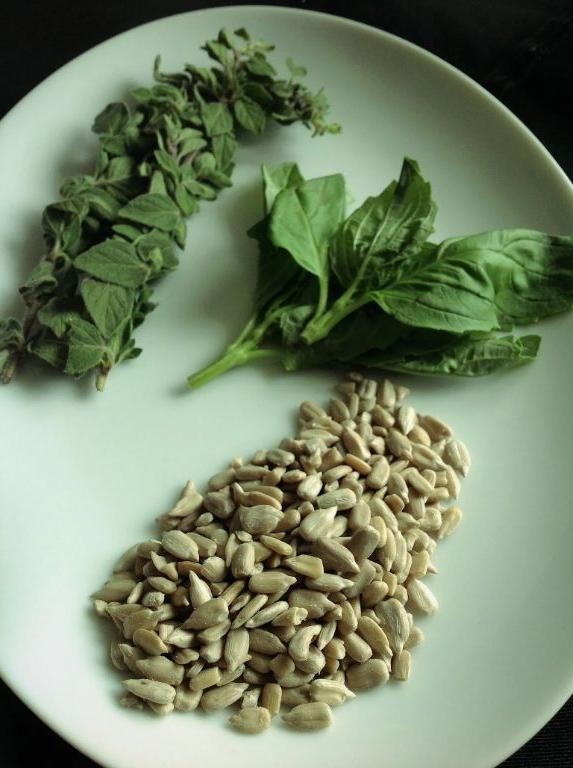
Now, let’s explore how to craft an exceptional oregano and sunflower seed pesto that will elevate your culinary repertoire with its vibrant herbal notes and nutty complexity. This versatile sauce transforms simple ingredients into something truly special through careful preparation and technique.
3
servings15
minutes10
minutesIngredients
- 2 cups fresh oregano leaves, tightly packed
- ¾ cup raw sunflower seeds
- 3 garlic cloves, peeled and smashed
- ½ cup extra virgin olive oil
- ¼ cup freshly grated Parmigiano-Reggiano cheese
- 2 tablespoons freshly squeezed lemon juice
- ½ teaspoon fine sea salt
- ¼ teaspoon freshly cracked black pepper
Instructions
- Preheat your oven to 350°F and line a baking sheet with parchment paper.
- Spread the raw sunflower seeds in a single layer on the prepared baking sheet.
- Toast the sunflower seeds in the preheated oven for 8-10 minutes until they become fragrant and develop a light golden color, shaking the pan halfway through for even toasting.
- Transfer the toasted sunflower seeds to a food processor bowl and allow them to cool completely, about 15 minutes.
- Add the fresh oregano leaves, smashed garlic cloves, and fine sea salt to the food processor with the cooled sunflower seeds.
- Pulse the mixture 10-12 times in 2-second bursts until the ingredients are coarsely chopped but not pureed.
- With the food processor running on low speed, slowly drizzle in the extra virgin olive oil through the feed tube over 30 seconds until the mixture emulsifies.
- Add the freshly grated Parmigiano-Reggiano cheese, freshly squeezed lemon juice, and freshly cracked black pepper to the food processor.
- Process the mixture for 15-20 seconds until it reaches a cohesive, slightly textured paste consistency.
- Transfer the finished pesto to an airtight container, pressing plastic wrap directly onto the surface to prevent oxidation.
Simply spoon this vibrant pesto over grilled chicken or toss it with roasted vegetables for an instant flavor upgrade. The texture should be pleasantly coarse with visible herb flecks, while the flavor profile balances earthy oregano against the toasty sunflower seeds and sharp cheese notes. Consider spreading it on crostini with ricotta or swirling it into warm pasta with reserved cooking water for different culinary applications.
Radish Leaf Pesto with Walnuts
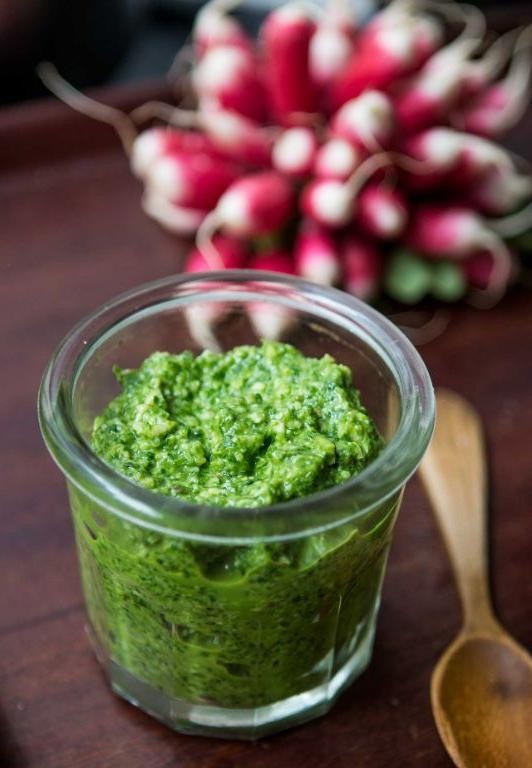
Did you know those vibrant radish tops you typically discard can be transformed into a sophisticated pesto? During my recent farmers market visit, I discovered how these peppery greens create an exceptional sauce when paired with toasted walnuts. Developing this recipe required careful attention to texture and flavor balance, resulting in a surprisingly elegant condiment.
4
servings15
minutes8
minutesIngredients
– 4 cups tightly packed fresh radish leaves, thoroughly washed and dried
– 3/4 cup raw walnut halves
– 2 medium garlic cloves, peeled and smashed
– 1/2 cup extra virgin olive oil
– 1/4 cup freshly grated Parmigiano-Reggiano cheese
– 2 tablespoons freshly squeezed lemon juice
– 1/2 teaspoon fine sea salt
Instructions
1. Preheat your oven to 350°F and arrange the walnut halves in a single layer on a baking sheet.
2. Toast the walnuts in the preheated oven for exactly 8 minutes until fragrant and lightly golden, checking at the 6-minute mark to prevent burning.
3. Transfer the toasted walnuts to a cutting board and allow them to cool completely to room temperature, about 10 minutes.
4. Place the cooled walnuts, radish leaves, smashed garlic cloves, and fine sea salt in the bowl of a food processor fitted with the steel blade.
5. Pulse the mixture 12-15 times in 2-second bursts until the ingredients are coarsely chopped but not pureed.
6. With the food processor running on low speed, slowly drizzle in the extra virgin olive oil through the feed tube over 30 seconds until emulsified.
7. Stop the processor and scrape down the sides with a rubber spatula to incorporate any unprocessed ingredients.
8. Add the freshly grated Parmigiano-Reggiano cheese and freshly squeezed lemon juice to the mixture.
9. Process the pesto for an additional 15 seconds on medium speed until the texture becomes creamy but maintains some texture from the walnuts.
10. Transfer the finished pesto to an airtight container, pressing plastic wrap directly onto the surface to prevent oxidation.
Offering a delightful crunch from the walnuts and bright acidity from the lemon, this pesto boasts a vibrant green color and pleasantly peppery finish. The coarse texture makes it ideal for spreading on crostini or tossing with al dente pasta, while the robust flavor stands up beautifully to grilled chicken or roasted vegetables.
Carrot Top Pesto with Pepitas
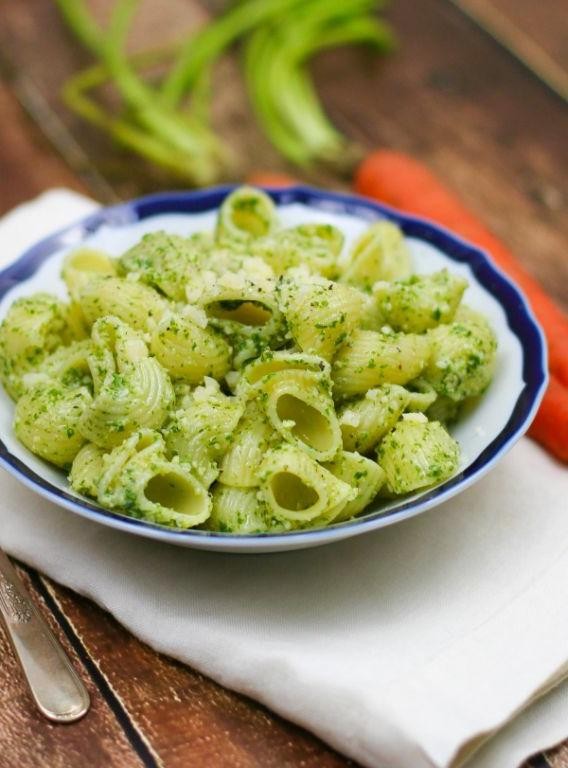
You’ve probably tossed those vibrant carrot tops without a second thought, but today we’re transforming them into a sophisticated pesto that will elevate your culinary repertoire. This methodical guide will walk you through creating a perfectly balanced Carrot Top Pesto with toasted pepitas, ensuring you achieve professional results with every step.
3
servings15
minutes7
minutesIngredients
– 2 cups fresh carrot tops, thoroughly washed and dried
– ½ cup raw pepitas
– 2 garlic cloves, peeled
– ½ cup extra virgin olive oil
– ¼ cup freshly grated Parmigiano-Reggiano
– 2 tablespoons freshly squeezed lemon juice
– ½ teaspoon fine sea salt
Instructions
1. Preheat your oven to 350°F and spread pepitas in a single layer on a baking sheet.
2. Toast pepitas for 5-7 minutes until they become fragrant and display light golden coloration.
3. Transfer toasted pepitas to a food processor bowl and allow them to cool completely to room temperature.
4. Add fresh carrot tops, peeled garlic cloves, and fine sea salt to the food processor.
5. Pulse the mixture 10-12 times in 2-second bursts until ingredients are coarsely chopped.
6. Scrape down the sides of the processor bowl with a rubber spatula to ensure even incorporation.
7. With the processor running on low speed, slowly drizzle in extra virgin olive oil through the feed tube over 30 seconds.
8. Add freshly grated Parmigiano-Reggiano and freshly squeezed lemon juice to the mixture.
9. Process for 15-20 seconds until the pesto reaches a cohesive, slightly textured consistency.
10. Transfer the finished pesto to an airtight container, pressing plastic wrap directly against the surface.Zesty and herbaceous with a delightful crunch from the toasted pepitas, this pesto boasts a vibrant green hue and complex earthy notes. The texture remains pleasantly coarse, making it ideal for spreading on crusty artisan bread or tossing with al dente pasta. For an elegant presentation, swirl it into roasted vegetable soups or use it as a marinade for grilled chicken.
Conclusion
Remarkable pesto possibilities await beyond pine nuts! These 19 creative recipes prove you can enjoy vibrant, flavorful pesto with accessible ingredients. I hope you find some new favorites to try in your kitchen. Share which recipe you loved most in the comments below, and don’t forget to pin this article to your Pinterest boards for easy reference. Happy cooking!
